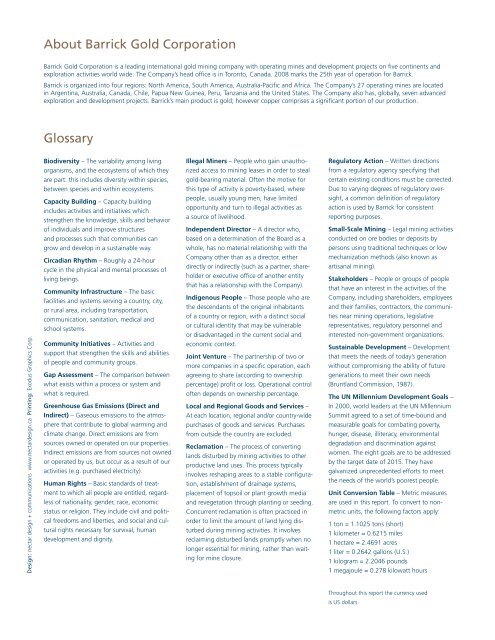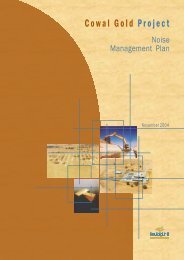2007 Responsibility Report - English (PDF) - Barrick Gold Corporation
2007 Responsibility Report - English (PDF) - Barrick Gold Corporation
2007 Responsibility Report - English (PDF) - Barrick Gold Corporation
- No tags were found...
You also want an ePaper? Increase the reach of your titles
YUMPU automatically turns print PDFs into web optimized ePapers that Google loves.
About <strong>Barrick</strong> <strong>Gold</strong> <strong>Corporation</strong><strong>Barrick</strong> <strong>Gold</strong> <strong>Corporation</strong> is a leading international gold mining company with operating mines and development projects on five continents andexploration activities world wide. The Company’s head office is in Toronto, Canada. 2008 marks the 25th year of operation for <strong>Barrick</strong>.<strong>Barrick</strong> is organized into four regions: North America, South America, Australia-Pacific and Africa. The Company’s 27 operating mines are locatedin Argentina, Australia, Canada, Chile, Papua New Guinea, Peru, Tanzania and the United States. The Company also has, globally, seven advancedexploration and development projects. <strong>Barrick</strong>’s main product is gold; however copper comprises a significant portion of our production.GlossaryDesign: nectar design + communications www.nectardesign.ca Printing: Exodus Graphics Corp.Biodiversity – The variability among livingorganisms, and the ecosystems of which theyare part: this includes diversity within species,between species and within ecosystems.Capacity Building – Capacity buildingincludes activities and initiatives whichstrengthen the knowledge, skills and behaviorof individuals and improve structuresand processes such that communities cangrow and develop in a sustainable way.Circadian Rhythm – Roughly a 24-hourcycle in the physical and mental processes ofliving beings.Community Infrastructure – The basicfacilities and systems serving a country, city,or rural area, including transportation,communication, sanitation, medical andschool systems.Community Initiatives – Activities andsupport that strengthen the skills and abilitiesof people and community groups.Gap Assessment – The comparison betweenwhat exists within a process or system andwhat is required.Greenhouse Gas Emissions (Direct andIndirect) – Gaseous emissions to the atmospherethat contribute to global warming andclimate change. Direct emissions are fromsources owned or operated on our properties.Indirect emissions are from sources not ownedor operated by us, but occur as a result of ouractivities (e.g. purchased electricity).Human Rights – Basic standards of treatmentto which all people are entitled, regardlessof nationality, gender, race, economicstatus or religion. They include civil and politicalfreedoms and liberties, and social and culturalrights necessary for survival, humandevelopment and dignity.Illegal Miners – People who gain unauthorizedaccess to mining leases in order to stealgold-bearing material. Often the motive forthis type of activity is poverty-based, wherepeople, usually young men, have limitedopportunity and turn to illegal activities asa source of livelihood.Independent Director – A director who,based on a determination of the Board as awhole, has no material relationship with theCompany other than as a director, eitherdirectly or indirectly (such as a partner, shareholderor executive office of another entitythat has a relationship with the Company).Indigenous People – Those people who arethe descendants of the original inhabitantsof a country or region, with a distinct socialor cultural identity that may be vulnerableor disadvantaged in the current social andeconomic context.Joint Venture – The partnership of two ormore companies in a specific operation, eachagreeing to share (according to ownershippercentage) profit or loss. Operational controloften depends on ownership percentage.Local and Regional Goods and Services –At each location, regional and/or country-widepurchases of goods and services. Purchasesfrom outside the country are excluded.Reclamation – The process of convertinglands disturbed by mining activities to otherproductive land uses. This process typicallyinvolves reshaping areas to a stable configuration,establishment of drainage systems,placement of topsoil or plant growth mediaand revegetation through planting or seeding.Concurrent reclamation is often practiced inorder to limit the amount of land lying disturbedduring mining activities. It involvesreclaiming disturbed lands promptly when nolonger essential for mining, rather than waitingfor mine closure.Regulatory Action – Written directionsfrom a regulatory agency specifying thatcertain existing conditions must be corrected.Due to varying degrees of regulatory oversight,a common definition of regulatoryaction is used by <strong>Barrick</strong> for consistentreporting purposes.Small-Scale Mining – Legal mining activitiesconducted on ore bodies or deposits bypersons using traditional techniques or lowmechanization methods (also known asartisanal mining).Stakeholders – People or groups of peoplethat have an interest in the activities of theCompany, including shareholders, employeesand their families, contractors, the communitiesnear mining operations, legislativerepresentatives, regulatory personnel andinterested non-government organizations.Sustainable Development – Developmentthat meets the needs of today’s generationwithout compromising the ability of futuregenerations to meet their own needs(Bruntland Commission, 1987).The UN Millennium Development Goals –In 2000, world leaders at the UN MillenniumSummit agreed to a set of time-bound andmeasurable goals for combating poverty,hunger, disease, illiteracy, environmentaldegradation and discrimination againstwomen. The eight goals are to be addressedby the target date of 2015. They havegalvanized unprecedented efforts to meetthe needs of the world’s poorest people.Unit Conversion Table – Metric measuresare used in this report. To convert to nonmetricunits, the following factors apply:1 ton = 1.1025 tons (short)1 kilometer = 0.6215 miles1 hectare = 2.4691 acres1 liter = 0.2642 gallons (U.S.)1 kilogram = 2.2046 pounds1 megajoule = 0.278 kilowatt hoursThroughout this report the currency usedis US dollars.
















